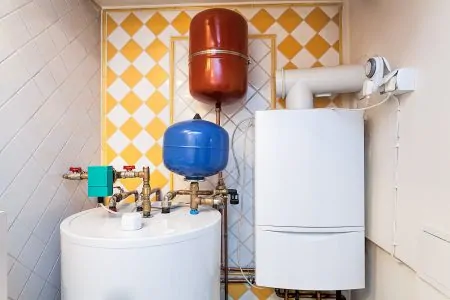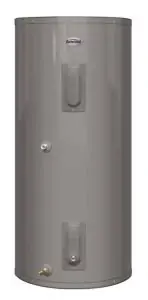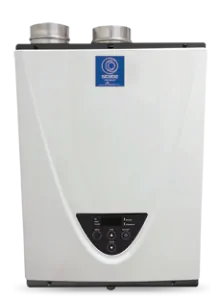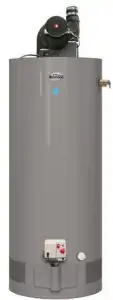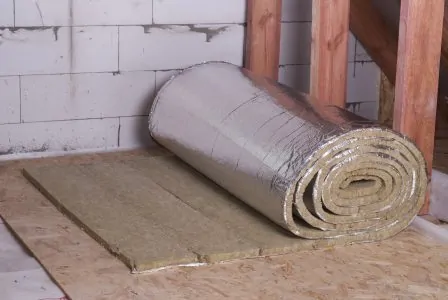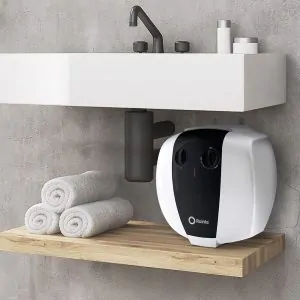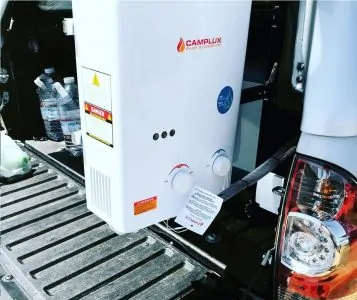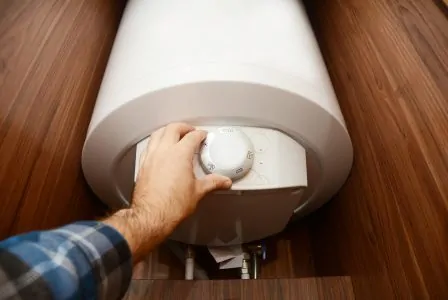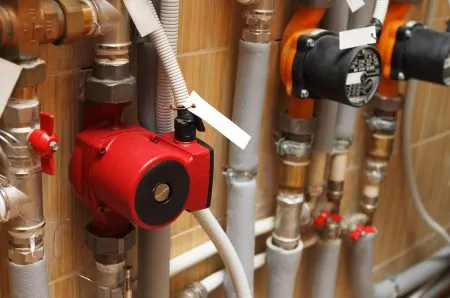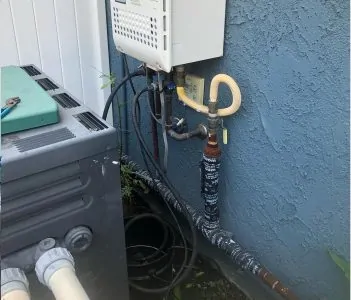Do you find yourself constantly running out of hot water? Does your hot water supply often fail to behave as it should? If so, it might be time to replace your existing water heater with a new model.
Choosing a new water heater is one of the most important decisions you can make in your home. It will supply your hot water, heat your home, and have a significant impact on your energy bills.
In this article, we will explore one of the key questions when choosing a new water heater: how large should it be? Making the right decision here will ensure your household has enough hot water, without wasting energy by heating too much.
Key Takeaways
- Consider household size: A 40-50 gallon tank is suitable for 2-3 people, while a 60-80 gallon tank is ideal for 4-6 people.
- Calculate peak hour demand: Determine the busiest time for hot water usage and ensure the water heater can handle the demand during that time.
- Choose the right type of water heater: Solar, tankless, and tank-type water heaters have different sizing requirements and energy efficiency levels.
- Factor in fuel type and energy costs: The fuel type (electric, gas, etc.) will affect the size of the water heater, its efficiency, and annual operating costs.
Types of Water Heaters
There are several types of water heater systems to choose from. We have taken a closer look at three of the most popular below.
1. Solar Water Heater Systems
These systems utilize the sun’s natural energy and incur low operational costs compared to standard gas or electric water heaters. However, many homeowners shy away from them due to the high initial costs to buy and install them.
The main components of this system are the storage tank and solar collector. The solar collector is a flat box consisting of a transparent cover and an insulated backplate. Within the collector, there are several tubes that carry a coolant (1).
For your heater to perform optimally, you need to consider how much of the sun’s energy reaches your building. The placement and tilt of the collector determine how efficient your heating system will be.
The best thing about these water heating systems is that they use both direct solar radiation and diffuse solar radiation. Those of us who don’t live in sunny climates can still access adequate solar resources.
This is especially true if the building is not shaded and mostly faces south. Before installing the solar system, it’s important to have the supplier or installer visit your home.
They will evaluate your building’s level of solar energy and advise you on the size and type of system needed. You will need one that can provide at least 90% of your household’s hot water needs in the summer.
On cloudy days or whenever your hot water usage increases, you will need a backup system. This can be a traditional water tank or a tankless system.
Solar hot water systems are low maintenance and may need a checkup every three to five years. It’s likely that you will only need to replace a part or two after 10 years.
Optimal placement is a key concern with a solar system’s collector. Consider the following before purchasing a solar hot water system:
Size of Solar Collector
In most cases, the installer or contractor will apply a guideline of roughly 20 square feet for the first two people. For each extra person, they add eight square feet if you live within the U.S. Sun Belt region.
For those living in the Northern United States, the contractor will add 12-14 square feet for each extra person.
Storage Volume
Here are some estimates that you can work with:
- A 50-gallon or 60-gallon tank can supply a household of one to three people.
- An 80-gallon storage tank should work well for a family of three or four people.
- Tanks exceeding 80 gallons are ideal for four to six people (2).
Building Codes and Regulations
Before installing a solar water heater, it’s important to discuss the matter with the municipal office. Speak to your neighborhood, community, and homeowners association (whichever applies) and let them know your intentions.
They will provide guidelines and restrictions you need to adhere to. Examples may include:
- The dimensions of your unit and maximum roof load.
- Erection of unlawful protrusions on roofs.
- Improper wiring.
- Obstruction of side yards.
- Placing your system too close to lot boundaries or streets.
Always remember to make copies of any approvals you receive for future reference (3).
2. Tankless Hot Water Systems
These hot water systems are gaining popularity in the US due to their efficiency and lower energy cost. They only generate hot water when needed. Tankless systems use either an electric element or a gas burner to heat the water.
When you open a hot water faucet, cold water moves through the pipe and into the unit. It is heated, then flows out as hot water.
A key advantage of this system is that hot water is effectively instantaneous — there is no waiting for a storage tank to fill up before you can use it. Most tankless water heater systems can be hung on walls, meaning they can easily fit into tight spaces.
Unlike tank types, there is no risk of springing a leak that could lose gallons of water and potentially cause a flood. You won’t have to worry about the tank tipping over in an earthquake if your area is susceptible to them. More importantly, Legionella bacteria won’t make their home in your system (4).
However, they aren’t without downsides. The output of a tankless water heater limits the flow rate. Generally, these heaters can provide 2-5 gallons of hot water per minute which may not be enough for multiple uses simultaneously.
This means you might not be able to run your dishwasher and take a hot shower at the same time. Ensuring you have enough hot water could require the installation of two or more water heaters.
Factors That Affect Sizing
Flow rate and temperature rise are the two main considerations when sizing a tankless water heater.
Flow Rate
To determine the necessary flow rate for your heater, calculate your peak hot water usage. This is the number of hot water appliances you expect to use simultaneously.
Think about your dishwasher, shower, and washing machines. Add up their flow rates, which are essentially how many gallons they use per minute (GPM). Here is an example to help put things in perspective:
- Shower – 2.5 GPM.
- Sink faucet – 1 GPM.
- Bathtub – 3 GPM.
- Dishwasher – 3 GPM.
- Washing Machine – 3 GPM.
Let’s assume that your peak hour of usage is in the morning. Someone might be in the shower while you’re running the dishwasher and one other person could be shaving. Your usage is 6.5 GPM, which means you need a heater with at least a 6.5 GPM flow rate.
Temperature rise
An easy way to determine the temperature rise is to let the cold water faucet run for a couple of minutes and then use a thermometer to measure its temperature.
On average, the hot water temperature for homes is around 110 degrees Fahrenheit. Subtract the cold water temperature from 110 degrees Fahrenheit to calculate the required temperature rise.
For example, if your cold water measurement is 65 degrees Fahrenheit, subtract this from 110 degrees Fahrenheit. This means the heater needs to heat the water by 45 degrees to arrive at 110 degrees Fahrenheit.
In this example, the temperature rise required is 45 degrees Fahrenheit (5).
All tankless water heaters have a chart that explains their hot water flow at various temperature rises. Use that information to adjust your heater accordingly.
3. Tank-Type Hot Water System
These conventional storage tanks are popular in many homes across the U.S. and provide a reservoir of prepared hot water. Whenever someone opens a faucet, hot water flows from the top of the tank. At the same time, cold water enters the bottom of the tank.
This ensures that the tank remains full of hot water. Unfortunately, as the water is constantly being heated whether you’re using hot water or not, energy is lost. This is referred to as standby heat loss.
If you’re wondering “what size water heater do I need?”, there are several factors to consider when choosing the right size. They include:
Physical Size
If you’re replacing your current tank with another of similar size, this isn’t an issue. However, circumstances change and you may find that a growing family will use more hot water in the future.
If you intend to purchase a larger tank, think about the space you need to fit it into.
Fuel Source
Conventional tank-type water heaters use different fuel sources, including liquid propane, natural gas, fuel oil, and electricity.
The fuel type and its availability affects the size of the water heater you should purchase. It will also affect its energy efficiency and annual operating costs (6).
Household Size
A large household is likely to use more water than a home of two people. However, it’s worth remembering that the required size truly depends on how much water your property uses — you could have a small family of 4 that still consumes more water than a larger one. Some general guidelines for tank water heater capacity are as follows:
- 30-40 gallons for one to two people.
- 40-50 gallons for two to three people.
- 50-60 gallons for three to four people.
- 60-80 gallons for five or more people.
These figures are only estimates. If you want a more accurate number, you will need to do some math. Here is what what you should be looking at:
Peak Hour Demand
Think about the time of day that you use the largest quantity of hot water in your home. Also, keep in mind the number of people living in your home.
First Hour Rating (FHR)
This refers to how much hot water the water heater can produce in a single hour. This figure should give you a much clearer idea of how many tasks it can handle during peak hours.
You can use the table below to come up with a better estimate of your peak hour demands. This will help you figure out your necessary FHR.
| Use | Average Gallons of Hot Water Per Usage | Times used In an Hour | Gallons Used Per Hour | ||
| Shower | 10 | X | X | ||
| Shaving (.05 GPM) | 2 | X | X | ||
| Hand dishwashing or food preparation (2 GPM) | 4 | X | X | ||
| Automatic dishwasher | 6 | X | X | ||
| Washing Machine | 7 | X | X | ||
| total Peak Hour Demand |
Example:
| 4 Showers | 10 | X | 4 | = | 40 |
| 1 Shave | 2 | X | 1 | = | 2 |
| 1 Auto dishwashing | 6 | X | 1 | = | 6 |
| Peak Hour Demand | 48 |
The above example shows a peak hour demand of 48 gallons. That means this family needs a water heater with an FHR of 50 gallons. A 40-gallon heater would leave them short of hot water when they need it most.
You will want to choose a model with an FHR that meets or exceeds your water usage at the busiest time of day (7).
There are some people who don’t believe shaving can consume two gallons of water. You might want to ask someone who lives in a large household, but we’ll leave that up to you!
